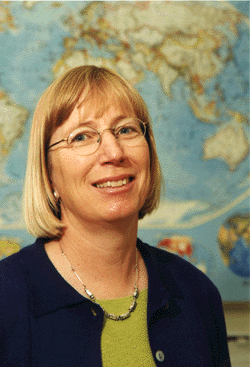
The Meaning of Life

In her masterpiece, “Frankenstein,” novelist Mary Shelley pioneered the notion of scientific hubris, and the theme remains front and center in modern works like Michael Crichton’s “Jurassic Park.”
Now scientists have begun working to create truly artificial life. The enterprise will likely yield insights into basic scientific questions as well as breakthroughs in medicine and technology. But as Shelley’s Dr. Frankenstein and Crichton’s Dr. Hammond discovered, such breakthroughs can have unintended consequences. Fortunately for the researchers, a team of social scientists will collaborate with them as they navigate these fraught waters.
UC Santa Barbara anthropology professor Barbara Herr Harthorn will lead a team in investigating the societal implications of two National Science Foundation (NSF) projects to create synthetic cells. The first, ProteoCell, aims to create a fully functional, programmable cell from the bottom up by using proteins and peptides to form the membranes and other important compartments of the cell. In the Synthetic Neuron project, scientists intend to develop an artificial neuron and neuronal system that can be controlled at the cellular and network levels.
The UC Santa Barbara group is collaborating with five institutions on the former project and six different institutions on the latter. Harthorn’s teams will contribute insight on the societal perspectives of each endeavor. Together, the projects total $8 million divided across all the partners. They are among four large, collaborative synthetic cell projects that emerged from an intensive, 5-day workshop of the NSF’s Ideas Lab on Building a Synthetic Cell. Considering the potential consequences of these new technologies was one of the priorities for the meeting.
According to Harthorn, the NSF stipulated that all the projects had to include a bioethics or risk perception component at the top level. “The fundamental idea is that you shouldn’t do the science first, and then ask what the public thinks about it. But rather, that the public has a right to participate in the scientific endeavor,” she said. “This is about trying to create synthetic life. This will be provocative.”
Fortunately, Harthorn is well-versed in examining the ramifications of new technologies. She previously served as the director of UC Santa Barbara’s Center for Nanotechnology in Society (CNS), which studied the societal implications of emerging nanotechnologies. At CNS, Harthorn and her collaborators developed a sophisticated suite of tools and techniques to probe public perceptions and preferences on cutting-edge science and technology, methods she plans to transfer to her work with synthetic biology.
“The goal here is to gain an understanding of how the diverse U.S. public will make sense of these new technologies, and then to work with the scientific community to consider and reflect on this,” she said.
A blank slate
Gauging public opinion on emerging technology presents a unique challenge: “It’s very tricky to ask people what they think about something they don’t know anything about,” Harthorn remarked. Researchers can conduct surveys, but the results offer little insight since there’s no way to know the thoughts that underlie participants’ responses.
Instead, social scientists find it far more informative to begin by conducting in-depth, open-ended, qualitative discussions. “We convene small, diverse groups of around 12 to 15 members of the lay public for face-to-face group engagement and deliberation,” she explained. These take the form of day-long workshops where the researchers provide participants with information about the new technology and then discuss their reactions, thoughts and perceptions.
Harthorn plans to conduct about three of these focus group-type meetings in California over the next year tied to the Synthetic Neuron project. Insights from these discussions, she said, will then inform two national surveys she intends to develop for the ProteoCell project.
Hit the road running
Now underway, the projects will run for three and four years respectively. Harthorn’s group is starting out by interviewing experts to familiarize themselves with the world of synthetic biology and synthetic cells. They will need to lean on the scientists to help create and vet educational material.
As they gather a better understanding of the public’s views on artificial cells, the researchers hope to bring their insights back to the scientists. “This will mean workshops and meetings where we bring to them the results of our research and jointly reflect on what they might mean for the research enterprise,” Harthorn said.
She also plans to use the Responsible Research and Innovation framework developed by the European Union to discuss how to incorporate public views into scientific planning. Ultimately, this will help inform scientists which avenues of research may be more contentious as well as how to communicate their work to the public.



